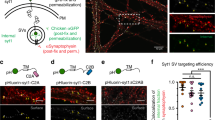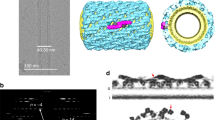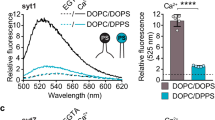Abstract
Neuronal communication is mediated by Ca2+-triggered fusion of transmitter-filled synaptic vesicles with the presynaptic plasma membrane. Synaptotagmin I functions as a Ca2+ sensor that regulates exocytosis, whereas soluble N-ethylmaleimide–sensitive factor attachment protein (SNAP) receptor (SNARE) proteins in the vesicle and target membrane assemble into complexes that directly catalyze bilayer fusion. Here we report that, before the Ca2+ trigger, synaptotagmin interacts with SNARE proteins in the target membrane to halt SNARE complex assembly at a step after donor vesicles attach, or dock, to target membranes. This results in fusion complexes that, when subsequently triggered by Ca2+, drive rapid, highly efficient lipid mixing. Ca2+-independent interactions with SNAREs also predispose synaptotagmin to selectively penetrate the target membrane in response to Ca2+; we demonstrate that Ca2+–synaptotagmin must insert into the target membrane to accelerate SNARE-catalyzed fusion. These findings demonstrate that Ca2+ converts synaptotagmin from a clamp to a trigger for exocytosis.
This is a preview of subscription content, access via your institution
Access options
Subscribe to this journal
Receive 12 print issues and online access
$189.00 per year
only $15.75 per issue
Buy this article
- Purchase on Springer Link
- Instant access to full article PDF
Prices may be subject to local taxes which are calculated during checkout







Similar content being viewed by others
References
Rothman, J.E. Mechanisms of intracellular protein transport. Nature 372, 55–63 (1994).
Jahn, R. & Scheller, R.H. SNAREs–engines for membrane fusion. Nat. Rev. Mol. Cell Biol. 7, 631–643 (2006).
Weber, T. et al. SNAREpins: minimal machinery for membrane fusion. Cell 92, 759–772 (1998).
Katz, B. The Release Of Neural Transmitter Substances (Thomas, Springfield, 1969).
Llinas, R., Steinberg, I.Z. & Walton, K. Relationship between presynaptic calcium current and postsynaptic potential in squid giant synapse. Biophys. J. 33, 323–351 (1981).
Sabatini, B.L. & Regehr, W.G. Timing of neurotransmission at fast synapses in the mammalian brain. Nature 384, 170–172 (1996).
Sun, J.Y. & Wu, L.G. Fast kinetics of exocytosis revealed by simultaneous measurements of presynaptic capacitance and postsynaptic currents at a central synapse. Neuron 30, 171–182 (2001).
Koh, T.W. & Bellen, H.J. Synaptotagmin I, a Ca2+ sensor for neurotransmitter release. Trends Neurosci. 26, 413–422 (2003).
Zhang, X., Kim-Miller, M.J., Fukuda, M., Kowalchyk, J.A. & Martin, T.F. Ca2+-dependent synaptotagmin binding to SNAP-25 is essential for Ca2+-triggered exocytosis. Neuron 34, 599–611 (2002).
Tucker, W.C., Weber, T. & Chapman, E.R. Reconstitution of Ca2+-regulated membrane fusion by synaptotagmin and SNAREs. Science 304, 435–438 (2004).
Bai, J., Wang, C.T., Richards, D.A., Jackson, M.B. & Chapman, E.R. Fusion pore dynamics are regulated by synaptotagmin*t-SNARE interactions. Neuron 41, 929–942 (2004).
Bhalla, A., Chicka, M.C., Tucker, W.C. & Chapman, E.R. Ca2+-synaptotagmin directly regulates t-SNARE function during reconstituted membrane fusion. Nat. Struct. Mol. Biol. 13, 323–330 (2006).
Perin, M.S., Fried, V.A., Mignery, G.A., Jahn, R. & Sudhof, T.C. Phospholipid binding by a synaptic vesicle protein homologous to the regulatory region of protein kinase C. Nature 345, 260–263 (1990).
Chapman, E.R. & Davis, A.F. Direct interaction of a Ca2+-binding loop of synaptotagmin with lipid bilayers. J. Biol. Chem. 273, 13995–14001 (1998).
Bai, J., Tucker, W.C. & Chapman, E.R. PIP2 increases the speed-of-response of synaptotagmin and steers its membrane penetration activity toward the plasma membrane. Nat. Struct. Mol. Biol. 11, 36–44 (2004).
Hui, E., Bai, J. & Chapman, E.R. Ca2+-triggered simultaneous membrane penetration of the tandem C2-domains of synaptotagmin I. Biophys. J. 91, 1767–1777 (2006).
Herrick, D.Z., Sterbling, S., Rasch, K.A., Hinderliter, A. & Cafiso, D.S. Position of synaptotagmin I at the membrane interface: cooperative interactions of tandem C2 domains. Biochemistry 45, 9668–9674 (2006).
Chapman, E.R. How does synaptotagmin trigger neurotransmitter release? Annu. Rev. Biochem. 77, 615–641 (2008).
Bhalla, A., Tucker, W.C. & Chapman, E.R. Synaptotagmin isoforms couple distinct ranges of Ca2+, Ba2+, and Sr2+ concentration to SNARE-mediated membrane fusion. Mol. Biol. Cell 16, 4755–4764 (2005).
Stein, A., Radhakrishnan, A., Riedel, D., Fasshauer, D. & Jahn, R. Synaptotagmin activates membrane fusion through a Ca2+-dependent trans interaction with phospholipids. Nat. Struct. Mol. Biol. 14, 904–911 (2007).
Chapman, E.R., Hanson, P.I., An, S. & Jahn, R. Ca2+ regulates the interaction between synaptotagmin and syntaxin 1. J. Biol. Chem. 270, 23667–23671 (1995).
Schiavo, G., Stenbeck, G., Rothman, J.E. & Sollner, T.H. Binding of the synaptic vesicle v-SNARE, synaptotagmin, to the plasma membrane t-SNARE, SNAP-25, can explain docked vesicles at neurotoxin-treated synapses. Proc. Natl. Acad. Sci. USA 94, 997–1001 (1997).
Schaub, J.R., Lu, X., Doneske, B., Shin, Y.K. & McNew, J.A. Hemifusion arrest by complexin is relieved by Ca2+-synaptotagmin I. Nat. Struct. Mol. Biol. 13, 748–750 (2006).
Martens, S., Kozlov, M.M. & McMahon, H.T. How synaptotagmin promotes membrane fusion. Science 316, 1205–1208 (2007).
Earles, C.A., Bai, J., Wang, P. & Chapman, E.R. The tandem C2 domains of synaptotagmin contain redundant Ca2+ binding sites that cooperate to engage t-SNAREs and trigger exocytosis. J. Cell Biol. 154, 1117–1123 (2001).
Takamori, S. et al. Molecular anatomy of a trafficking organelle. Cell 127, 831–846 (2006).
Melia, T.J. et al. Regulation of membrane fusion by the membrane-proximal coil of the t-SNARE during zippering of SNAREpins. J. Cell Biol. 158, 929–940 (2002).
Pobbati, A.V., Stein, A. & Fasshauer, D. N- to C-terminal SNARE complex assembly promotes rapid membrane fusion. Science 313, 673–676 (2006).
Geppert, M. et al. Synaptotagmin I: a major Ca2+ sensor for transmitter release at a central synapse. Cell 79, 717–727 (1994).
Pang, Z.P., Sun, J., Rizo, J., Maximov, A. & Sudhof, T.C. Genetic analysis of synaptotagmin 2 in spontaneous and Ca2+-triggered neurotransmitter release. EMBO J. 25, 2039–2050 (2006).
Bai, J., Earles, C.A., Lewis, J.L. & Chapman, E.R. Membrane-embedded synaptotagmin penetrates cis or trans target membranes and clusters via a novel mechanism. J. Biol. Chem. 275, 25427–25435 (2000).
Melia, T.J., You, D., Tareste, D.C. & Rothman, J.E. Lipidic antagonists to SNARE-mediated fusion. J. Biol. Chem. 281, 29597–29605 (2006).
de Wit, H., Cornelisse, L.N., Toonen, R.F. & Verhage, M. Docking of secretory vesicles is syntaxin dependent. PLoS ONE 1, e126 (2006).
Hammarlund, M., Palfreyman, M.T., Watanabe, S., Olsen, S. & Jorgensen, E.M. Open syntaxin docks synaptic vesicles. PLoS Biol. 5, e198 (2007).
Wojcik, S.M. & Brose, N. Regulation of membrane fusion in synaptic excitation-secretion coupling: speed and accuracy matter. Neuron. 55, 11–24 (2007).
McMahon, H.T., Missler, M., Li, C. & Sudhof, T.C. Complexins: cytosolic proteins that regulate SNAP receptor function. Cell 83, 111–119 (1995).
Reim, K. et al. Complexins regulate a late step in Ca2+-dependent neurotransmitter release. Cell 104, 71–81 (2001).
Xue, M. et al. Distinct domains of complexin I differentially regulate neurotransmitter release. Nat. Struct. Mol. Biol. 14, 949–958 (2007).
Giraudo, C.G., Eng, W.S., Melia, T.J. & Rothman, J.E. A clamping mechanism involved in SNARE-dependent exocytosis. Science 313, 676–680 (2006).
Tang, J. et al. A complexin/synaptotagmin 1 switch controls fast synaptic vesicle exocytosis. Cell 126, 1175–1187 (2006).
Itakura, M., Misawa, H., Sekiguchi, M., Takahashi, S. & Takahashi, M. Transfection analysis of functional roles of complexin I and II in the exocytosis of two different types of secretory vesicles. Biochem. Biophys. Res. Commun. 265, 691–696 (1999).
Huntwork, S. & Littleton, J.T. A complexin fusion clamp regulates spontaneous neurotransmitter release and synaptic growth. Nat. Neurosci. 10, 1235–1237 (2007).
Monck, J.R. & Fernandez, J.M. The exocytotic fusion pore. J. Cell Biol. 119, 1395–1404 (1992).
Kozlov, M.M. & Chernomordik, L.V. The protein coat in membrane fusion: lessons from fission. Traffic 3, 256–267 (2002).
Marrink, S.J. & Mark, A.E. The mechanism of vesicle fusion as revealed by molecular dynamics simulations. J. Am. Chem. Soc. 125, 11144–11145 (2003).
Chen, Y.A., Scales, S.J., Patel, S.M., Doung, Y.C. & Scheller, R.H. SNARE complex formation is triggered by Ca2+ and drives membrane fusion. Cell 97, 165–174 (1999).
Davis, A.F. et al. Kinetics of synaptotagmin responses to Ca2+ and assembly with the core SNARE complex onto membranes. Neuron 24, 363–376 (1999).
Jackson, M.B. & Chapman, E.R. Fusion pores and fusion machines in Ca2+-triggered exocytosis. Annu. Rev. Biophys. Biomol. Struct. 35, 135–160 (2006).
Desai, R.C. et al. The C2B domain of synaptotagmin is a Ca2+-sensing module essential for exocytosis. J. Cell Biol. 150, 1125–1136 (2000).
Bark, I.C. & Wilson, M.C. Human cDNA clones encoding two different isoforms of the nerve terminal protein SNAP-25. Gene 139, 291–292 (1994).
Bennett, M.K., Calakos, N. & Scheller, R.H. Syntaxin: a synaptic protein implicated in docking of synaptic vesicles at presynaptic active zones. Science 257, 255–259 (1992).
Parlati, F. et al. Rapid and efficient fusion of phospholipid vesicles by the α-helical core of a SNARE complex in the absence of an N-terminal regulatory domain. Proc. Natl. Acad. Sci. USA 96, 12565–12570 (1999).
Gitler, D. et al. Different presynaptic roles of synapsins at excitatory and inhibitory synapses. J. Neurosci. 24, 11368–11380 (2004).
Acknowledgements
We thank members of the Chapman laboratory, W. Tucker, J.M. Edwardson and M. Jackson for helpful discussions. This work was supported by the Howard Hughes Medical Institute and by grants from the American Heart Association and US National Institutes of Health.
Author information
Authors and Affiliations
Contributions
M.C.C. carried out all biochemical experiments and fusion assays, and, together with E.R.C., planned all experiments and wrote the manuscript; E.H. carried out the fluorescence experiments in Figure 7; and H.L. carried out the electrophysiology and neuronal imaging experiments shown in Figure 5d–g and Supplementary Figure 3.
Corresponding author
Supplementary information
Supplementary Text and Figures
Supplementary Figures 1–5 and Supplementary Methods (PDF 6620 kb)
Rights and permissions
About this article
Cite this article
Chicka, M., Hui, E., Liu, H. et al. Synaptotagmin arrests the SNARE complex before triggering fast, efficient membrane fusion in response to Ca2+. Nat Struct Mol Biol 15, 827–835 (2008). https://doi.org/10.1038/nsmb.1463
Received:
Accepted:
Published:
Issue Date:
DOI: https://doi.org/10.1038/nsmb.1463
This article is cited by
-
Synaptotagmin-7 outperforms synaptotagmin-1 to promote the formation of large, stable fusion pores via robust membrane penetration
Nature Communications (2023)
-
Resolving kinetic intermediates during the regulated assembly and disassembly of fusion pores
Nature Communications (2020)
-
Structural basis for the clamping and Ca2+ activation of SNARE-mediated fusion by synaptotagmin
Nature Communications (2019)
-
Synaptotagmin-1 enables frequency coding by suppressing asynchronous release in a temperature dependent manner
Scientific Reports (2019)
-
Synaptotagmin 17 controls neurite outgrowth and synaptic physiology via distinct cellular pathways
Nature Communications (2019)



